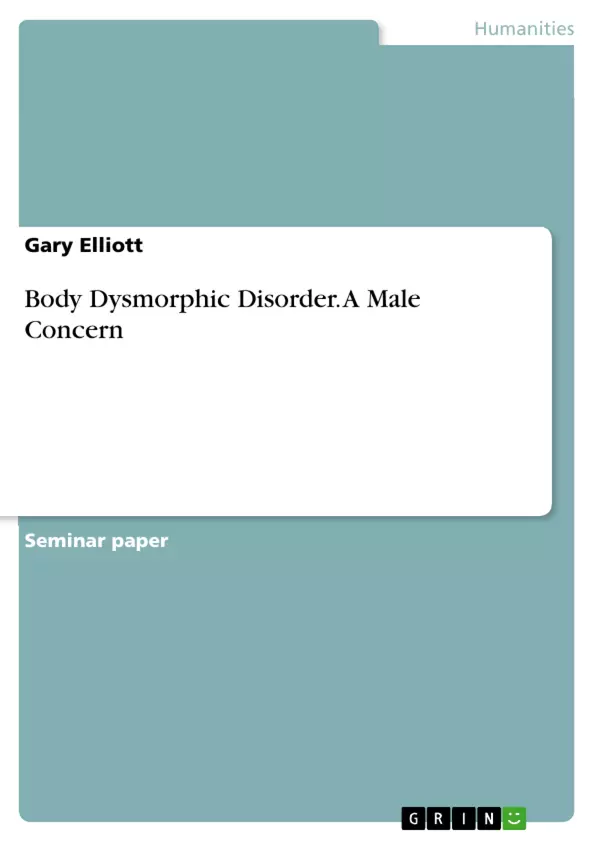Body Dysmorphic Disorder (BDD) is ‘a psychiatric illness in which patients become obsessively preoccupied with perceived flaws in their appearance’ (Luciano 2002: p175). Martin & Costello (2008) view it is a severe dislike and concern about some slight or imagined aspect of their appearance, that causes them significant emotional distress and difficulties. Cash (2008) maintains that sufferers have ‘a grossly distorted view of what they look like’ and Phillips (2005) coins BDD as ‘the disorder of imagined ugliness’ (p5).
Body Dysmorphic Disorder is classified as a somatoform disorder because the primary focus is a psychological preoccupation with a somatic issue. (Barlow & Durand: 2005) Thompson (2000) explains that the term that preceded Body Dysmorphic Disorder was ‘dysmorphophobia’ which was used by Morselli in 1886 (Morselli, 1886) which literally meant a ‘fear of ugliness’. In 1903, Janet’s description referred to an ‘obsession with shame of the body’; for decades BDD was thought to represent a ‘psychotic delusional state’ (Barlow & Durand: 2005, p183). The first English language paper on dysmorphophobia was not published until 1970 (Hay: 1970) focusing on the fear of other people’s reactions to the imagined flaw in appearance. BDD gained official status in 1987 when it was first published in the DSM-III-R
Jim was convinced that everyone, even his good friends, was staring at a part of his body that he himself found absolutely grotesque. He reported that strangers would never mention his deformity and his friends felt too sorry for him to mention it. Jim thought his head was square! Jim could not imagine people getting past the fact that his head was square. To hide his condition as well as he could, Jim wore soft floppy hats and was most comfortable in winter, when he could all but completely cover his head with a large stocking cap. To us, Jim looked perfectly normal. (Barlow & Durand: 2005)
In the article ‘Body Dysmorphic Disorder in men, psychiatric treatments are usually effective’, Katharine Phillips notes that BDD is an underrecognised yet relatively common and severe psychiatric disorder. Many doctors…do not recognize the condition as yet and simply see it as low self-esteem’ (Paterson: 2008, p51) Claiborn & Pedrick (2002) focus their attention on the two predominant features of BDD; the preoccupation with the [imagined] defect and the actions taken to reduce the feelings of distress.
How do I know if I have Body Dysmorphic Disorder?...
Inhaltsverzeichnis (Table of Contents)
- What is Body Dysmorphic Disorder?
- How do I know if I have Body Dysmorphic Disorder?
- Different forms of Body Dysmorphic Disorder...
- Muscle Dysmorphia..
- BDD by proxy..
- Obsessions and BDD...
- Compulsions and BDD...
- Cases of males with BDD - examples.
- Causes of BDD...
- BDD and gender – a male slant
- How does BDD affect the male sufferer?.
- Treatment options for BDD sufferers...
- Medication
- Cognitive-Behavioural Therapy.
- Cosmetic treatments.
- BDD and other disorders...
- Obsessive-Compulsive Disorder.
- Depression......
- Eating Disorders..
- Social Phobia
- Family assistance for the sufferer...
- Where to get help for the sufferer…..\li>
- Organizations.
- Books and Websites for further reading
- References....
Zielsetzung und Themenschwerpunkte (Objectives and Key Themes)
This document explores Body Dysmorphic Disorder (BDD), particularly its prevalence and impact on men. The text aims to provide a comprehensive overview of the disorder, its causes, symptoms, and treatment options. It highlights the often-overlooked nature of BDD, especially among males, and emphasizes the importance of recognizing and addressing the condition.
- Body Dysmorphic Disorder (BDD) and its characteristics
- The prevalence and underdiagnosis of BDD in men
- The impact of BDD on men's mental and social well-being
- Available treatment options for BDD sufferers
- The relationship between BDD and other mental health disorders
Zusammenfassung der Kapitel (Chapter Summaries)
- **What is Body Dysmorphic Disorder?** This chapter defines BDD as a mental health condition characterized by an obsessive preoccupation with perceived flaws in one's appearance. It discusses the history of the disorder, its classification as a somatoform disorder, and its impact on sufferers' lives.
- **How do I know if I have Body Dysmorphic Disorder?** This chapter provides a deeper understanding of BDD by outlining the diagnostic criteria and symptoms. It emphasizes the subjective nature of the perceived flaws and the significant distress and impairment caused by the disorder.
- **Different forms of Body Dysmorphic Disorder…** This chapter introduces various forms of BDD, focusing on Muscle Dysmorphia as a common subtype. It explores the specific concerns and behaviors associated with this form of the disorder, highlighting its prevalence among men.
Schlüsselwörter (Keywords)
The core concepts explored in this document include Body Dysmorphic Disorder (BDD), Muscle Dysmorphia, obsessive-compulsive disorder, depression, eating disorders, social phobia, treatment options, cognitive-behavioral therapy, medication, and cosmetic treatments. These keywords encompass the main themes, research focuses, and critical concepts related to BDD and its impact on men.
- Quote paper
- Gary Elliott (Author), 2010, Body Dysmorphic Disorder. A Male Concern, Munich, GRIN Verlag, https://www.grin.com/document/275075



